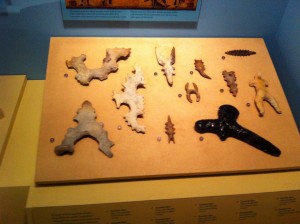
Caption below the display: "Because of their unusual shapes these flints are called 'eccentrics.' Although they appear to be stone tools, archaeologist have found collections of them in Maya tombs, suggesting they were offerings. We don't know what the 'eccentric' flints depict, but their unusual shapes spark the imagination."
Over fall break, I had the opportunity to visit the Field Museum of Natural History in Chicago. The museum boasts an astounding number of artifacts and many detailed exhibits, including an exhibit focused on past cultures that resided in the Americas. In a darkly lit room on Mayan culture, next to some ominous looking sacrificial “blood urns”, I noticed some oddly shaped objects labeled “eccentric” flints. The description explained that they were at first believed to be stone tools but because of the context in which they were found (tombs), they were deduced to be burial offerings. The archaeologists studying these flints used the “convergence of evidence” (Feder 40) to identify the purpose of these tools.
I also noted that the write-up below the display admitted that the archaeologists do not know what the stones depict, but that “their unusual shapes spark the imagination”. Many pseudoarchaeologists take this idea to an extreme. Take for example, Erich von Daniken, the author of the book and film Chariots of the Gods? Unsolved Mysteries of the Past. In his film, he makes the extreme claim that aliens visited past civilizations and provided them with many advanced technologies. Much of the evidence that Daniken provided were examples of artwork that he believed depicted aliens or that a particular temple or building simply looked like modern rockets, spaceships, or spacemen.

Stone engraving that Daniken believes depicts a man operating a spaceship, based on his observations of the image
Daniken provides known facts about the civilizations to convince the viewer of his knowledge and then share his completely out of the blue opinion that aliens contacted them in the past. I say opinion and not fact because Daniken does not use science or archaeology to test his hypothesis that aliens visited the ancient civilizations. If he had been addressing his hypothesis from a scientific stance, he would be sharing facts he discovered that were directly in support of his claims, because the purpose of collecting facts are to “explain something or test a hypothesis” (Feder 29). Instead, Daniken shares unrelated facts (an example of pseudoscience) to fool the viewer into believing what his is saying is fact, ignoring the truth and substituting his own.
If the viewer were paying any attention at all to the film, they would quickly realized that he shares no concrete evidence at all. His methods of research is like cloud watching. I may look up and see a cat. You may look up at the same cloud and see a bird. Since their is no evidence that it is not a cat and is in fact a bird, I can still say that I see a cat because there is nothing to prove me wrong. If Daniken were to observe the “eccentrics”, he may interpret them as a representation of alien figures, even if there is no evidence to support him. But science knows not to jump to conclusions without evidence, even if that means leaving something unresolved. This doesn’t mean the truth will forever be unknown- it has just not been discovered yet.

